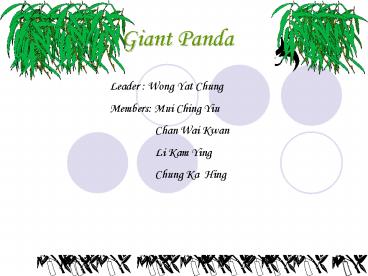Giant Panda - PowerPoint PPT Presentation
1 / 10
Title:
Giant Panda
Description:
... are often called pandas or panda bears, although their scientific name is Ailurpoda Melanoleuca. ... an omnivore, the giant panda's diet consists of 99 ... – PowerPoint PPT presentation
Number of Views:47
Avg rating:3.0/5.0
Title: Giant Panda
1
Giant Panda
Leader Wong Yat Chung Members Mui Ching Yiu
Chan Wai Kwan Li
Kam Ying Chung Ka Hing
2
Description
Habitat
Reproduction
Problems
Solutions
Summary
The Way To Preserve The Species
3
Description
Giant pandas are an endangered species. They are
often called pandas or panda bears, although
their scientific name is Ailurpoda Melanoleuca.
Being an omnivore, the giant pandas diet
consists of 99 bamboo along with small
percentages of fish, pikas, rodents, vines,
irises, crocus, and murice grass. Pandas eat in a
sitting position and since they eat about twelve
hours a day, they sit a lot! During these twelve
hours the pandas will have consumed somewhere
between twenty-three and thirty-six pounds of
food. Pandas may eat a lot, but they can be very
picky eaters. There are twenty-five types of
bamboo in our world that pandas will eat. Captive
pandas will only eat nine of these. The pandas
eating habits are an important part of their
life, this is what they spend a lot of their time
doing. The giant panda is a large mammal
weighing between 165-353 pounds. Its body length
is between 4-5 feet including a tail that is five
inches long. Their vision is poor but their sense
of smell is excellent. They have a woolly black
and white coat, which is slightly oily to prevent
water penetration. Giant pandas are a very
beautiful animal. This is why we have to so
everything we can to save them. But I think if
panda breeding habits can be perfected maybe the
giant pandas will not become extinct.
4
Habitat
Giant pandas are found only in the dense bamboo
and coniferous mountains of central China -- They
occupy 6 small forest fragments in small isolated
areas of the north and central portions of the
Sichuan Province, in the mountains bordering the
southernmost part of Gansu Province, and in the
Qinling Mountains of the Shaanxi Province (about
5,400 square miles).
The elevation ranges from 1,200 to 3,400 meters
(4,000 to 11,000 feet) high. The mountains are
shrouded in heavy clouds with torrential rains or
a dense mist throughout the year. In most of the
areas in which they still roam wild, they must
compete with the farmers who farm the river
valleys and the lower slopes of the mountains.
5
Reproduction
Pandas reach sexual maturity from four-and-a-half
to six-and-a half years of age and mate during
the spring, from March to May. Females are in
estrus for one to three weeks, but peak
receptiveness lasts for only a few days. Litters
of one, two, or occasionally three cubs are born
in August or September, usually in a hollow tree
or cave. Sometime, two cubs may be born from one
mother at the same time, but only one will
survive. The reason for this is because one baby
panda alone requires a lot of care and two is
even harder so usually the mother chooses one and
takes care of just that one. Although cubs are
usually weaned at about nine months of age, they
remain with their mothers for up to 18 months.
6
Problems
There are a few reasons why the giant panda is
endangered. One reason is that the panda breeding
season takes place only from March to May. This
makes it harder to breed a lot of pandas and
increase the panda population. A second reason
that pandas are endangered is because of where
they live in the wild. Giant pandas are
restricted to certain areas of China, their
habitat, so that means that there is not enough
space for all the pandas to live in. A third
reason is because when humans put them into
captivity, the pandas will become dependent on
humans and will not be able to go back into the
wild. This could be a problem but also a solution
because when pandas are captive humans tries to
breed them but they have been unsuccessful.
7
Solutions
Its true that pandas are endangered, but its
not because humans havent tried. There are many
ways that humans have tried to save them. But
they havent been successful. Humans have passed
a law that protected pandas and other wild life
from commercial trade and over-hunting. Also
theyve tried to save the giant pandas by
breeding them. This was unsuccessful because as
you know the giant pandas only breed at a certain
time. That is not enough time to breed many
pandas. Humans have also tried to make their
habitats into reserves to protect them from being
hunted.
8
The Way To Preserve The Species
Human destruction is the most critical factor in
the fate of the pandas, so we suggest some way to
preserve the species
- Reduction of human activities in the panda
habitat - Removal of human settlements
- Control of poaching
- Rehabilitation of habitat
- Management of bamboo habitat
- Extension of the panda Reserve system
- Achieving outbreeding between panda populations
- Maintaining a captive population
- Release of captive-born pandas into the wild
9
Summary
We had decided to study the giant panda because
of its unique features. Weve learned about how
they breed, where they live, what they eat, and
much more. Unfortunately, many people will not
have the opportunity to learn about this species
if they become extinct. We also hope that humans
will raise their awareness of this problem, and
soon find a solution.
10
The
!
End































